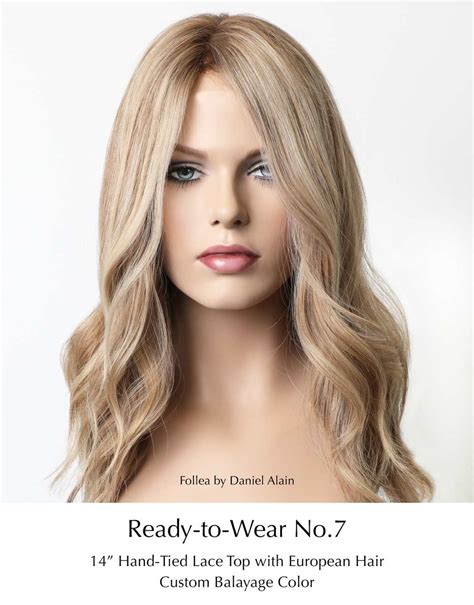Ready to Wear Wigs: The Ultimate Solution for Hair Loss and Style Transformation
Pain Points:

- Hair loss due to medical conditions (e.g., cancer treatment), alopecia, or thinning hair
- Unsatisfactory or time-consuming hair styling routines
- Limited access to professional hairdressers or expensive salon services
Motivations:
- Regain confidence and self-esteem
- Enhance personal style and appearance
- Protect hair from damage and promote hair growth
- Convenience and time-saving
Why Ready-to-Wear Wigs Matter
Benefits:
- Instant hair transformation: Achieve a new look in minutes without cutting or styling your natural hair.
- Versatile styling options: Choose from countless wig styles, colors, and lengths that match your preferences.
- Protection and hair health: Cover up hair loss or damage while protecting your scalp and promoting hair growth.
- Convenience and cost-effectiveness: Ready-to-wear wigs are affordable, easy to care for, and can eliminate the need for expensive salon visits.
Market Statistics and Growth Projections
According to the American Academy of Dermatology, over 50 million Americans experience hair loss, with 40% of women reporting thinning hair. The global hair wig market is expected to reach $13.1 billion by 2028, growing at a CAGR of 6%.
Types of Ready-to-Wear Wigs
Synthetic Wigs:
- Made from artificial fibers (e.g., nylon, acrylic)
- Affordable and low-maintenance
- Can appear shiny or less natural-looking
Human Hair Wigs:
- Made from real human hair
- More expensive and require more care
- Provide a natural and realistic appearance
Other Types of Wigs:
- Lace Front Wigs: Provide a natural-looking hairline with lace that blends with the skin.
- Mono Top Wigs: Have a thin layer of monofilament fabric at the crown for a scalp-like appearance.
- 360 Lace Wigs: Cover the entire head with lace for a seamless transition around the hairline.
How to Choose the Right Ready-to-Wear Wig
- Consider your face shape: Different wig styles complement different face shapes, such as oval, round, square, and heart-shaped.
- Match your skin tone: Choose a wig color that complements your skin undertones (warm, cool, or neutral).
- Determine your hair density: Select a wig with a hair density that matches your natural hair.
- Read customer reviews: Research and read reviews from other customers to get insights into wig quality and fit.
Care and Maintenance of Ready-to-Wear Wigs
- Wash regularly: Use a gentle shampoo designed specifically for wigs.
- Condition regularly: Apply a wig conditioner to keep the hair soft and tangle-free.
- Avoid heat styling: Limit the use of heat tools to prevent damage and extend the life of the wig.
- Store properly: Store your wig on a wig stand or in a box when not in use.
Innovative Applications of Ready-to-Wear Wigs
Beyond hair loss coverage, ready-to-wear wigs are finding new applications, including:
- Cosplay and costume play: Enhance character transformations with wigs designed for specific costumes.
- Fashion experiments: Try out different hair styles and colors without committing to permanent changes.
- Hair extension alternatives: Add volume and length to your natural hair without the use of extensions.
- Wiggling: A new term for experimenting with different wig styles and colors for self-expression and entertainment.
Conclusion
Ready-to-wear wigs offer a convenient and transformative solution for hair loss, style enhancement, and personal expression. With the wide variety of options available, individuals can find the perfect wig to match their needs and create the desired look. As the market continues to grow, we can expect even more innovative applications and advancements in the world of ready-to-wear wigs.
Appendix
Table 1: Types of Ready-to-Wear Wigs
| Type | Material | Appearance | Care |
|---|---|---|---|
| Synthetic | Artificial fibers | Affordable, easy to care for | Can appear shiny |
| Human Hair | Real human hair | Natural and realistic | More expensive, requires more care |
| Lace Front | Lace at the hairline | Natural-looking hairline | Requires more maintenance |
| Mono Top | Monofilament at the crown | Scalp-like appearance | More breathable |
| 360 Lace | Lace covers the entire head | Seamless transition | Difficult to put on |
Table 2: Wig Styles
| Style | Description |
|---|---|
| Bob | Short, blunt cut |
| Pixie | Short, layered cut |
| Long Layered | Layers throughout the hair |
| Curly | Defined curls |
| Straight | Smooth, straight hair |
Table 3: Wig Colors
| Color | Description |
|---|---|
| Black | Natural black shade |
| Brown | Range of brown shades, from light to dark |
| Blonde | Range of blonde shades, from golden to platinum |
| Red | Various shades of red, from copper to auburn |
| Ombre | Gradual shift from one color to another |
Table 4: Wig Care Tips
| Tip | Description |
|---|---|
| Wash regularly | Use a gentle shampoo designed for wigs. |
| Condition regularly | Apply a wig conditioner to keep the hair soft. |
| Avoid heat styling | Limit the use of heat tools. |
| Store properly | Store your wig on a wig stand or in a box. |
